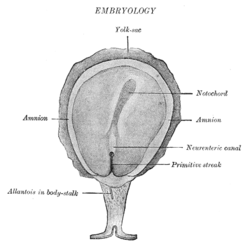Amnion
| Amnion | |
|---|---|

Surface view of embryo of Hylobates concolor.
|
|

Human fetus, enclosed in the amnion.
|
|
| Details | |
| Identifiers | |
| Latin | Amniosinas |
| MeSH | A10.615.284.277 |
| TE | E6.0.1.2.0.0.9 |
| FMA | 80223 |
|
Anatomical terminology
[]
|
|
The amnion is a membrane that closely covers the embryo when first formed. It fills with the amniotic fluid which causes the amnion to expand and become the amniotic sac which serves to provide a protective environment for the developing embryo. It is a feature of the amniotes which includes reptiles, birds, and mammals. Amphibians and fish are excluded from this group. The amnion stems from the extraembryonic somatic mesoderm on the outer side and the extraembryonic ectoderm on the inner side.
In the human embryo, the earliest stages of the formation of the amnion have not been observed; in the youngest embryo which has been studied the amnion was already present as a closed sac, and appears in the inner cell-mass as a cavity. This cavity is roofed in by a single stratum of flattened, ectodermal cells, the amniotic ectoderm, and its floor consists of the prismatic ectoderm of the embryonic disk—the continuity between the roof and floor being established at the margin of the embryonic disk. Outside the amniotic ectoderm is a thin layer of mesoderm, which is continuous with that of the somatopleure and is connected by the body-stalk with the mesodermal lining of the chorion.
When first formed, the amnion is in contact with the body of the embryo, but about the fourth or fifth week amniotic fluid (also called liquor amnii) begins to accumulate within it. This fluid increases in quantity and causes the amnion to expand and ultimately to adhere to the inner surface of the chorion, so that the extra-embryonic part of the coelom is obliterated. The amniotic fluid increases in quantity up to the sixth or seventh month of pregnancy, after which it diminishes somewhat; at the end of pregnancy it amounts to about 1 liter.
The amniotic fluid allows the free movements of the fetus during the later stages of pregnancy, and also protects it by diminishing the risk of injury from without. It contains less than two percent solids, consisting of urea and other extractives, inorganic salts, a small amount of protein, and frequently a trace of sugar. That some of the liquor amnii is swallowed by the fetus is proved by the fact that epidermal debris and hairs have been found among the contents of the fetal alimentary canal.
...
Wikipedia
